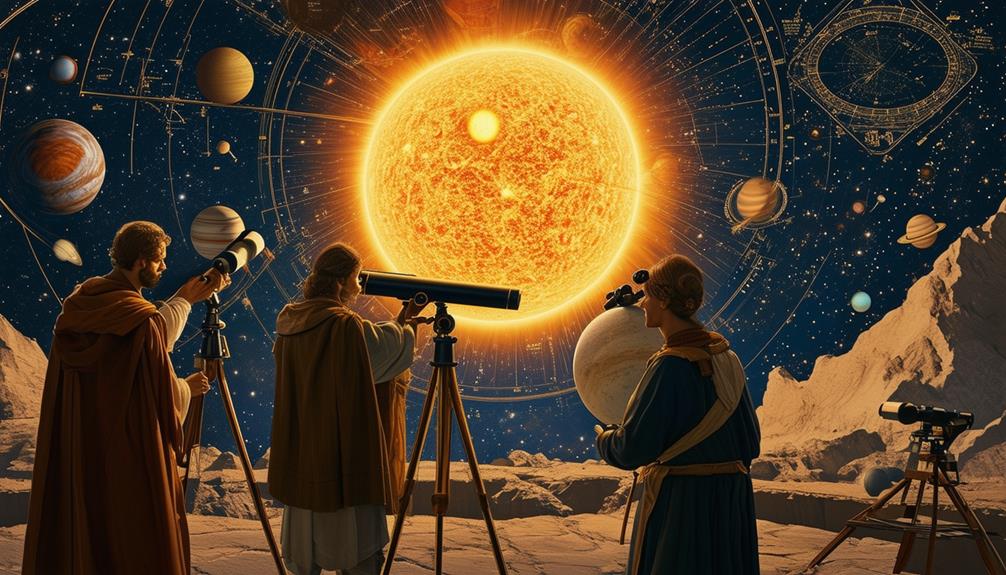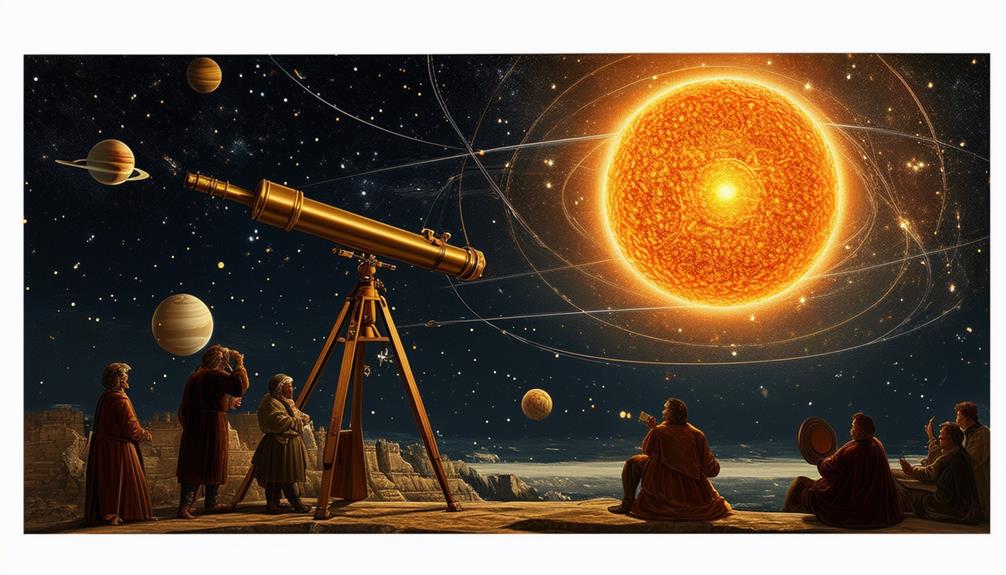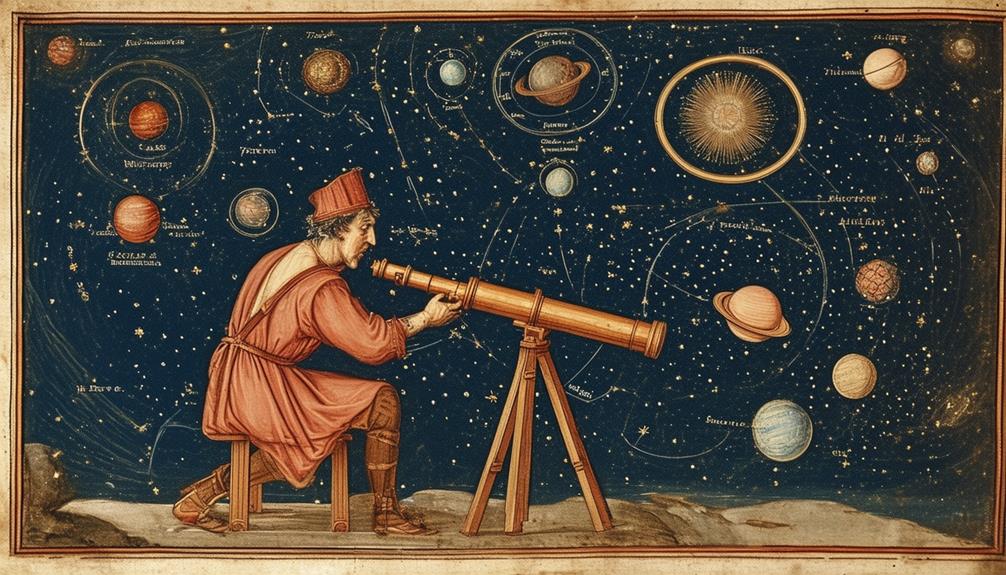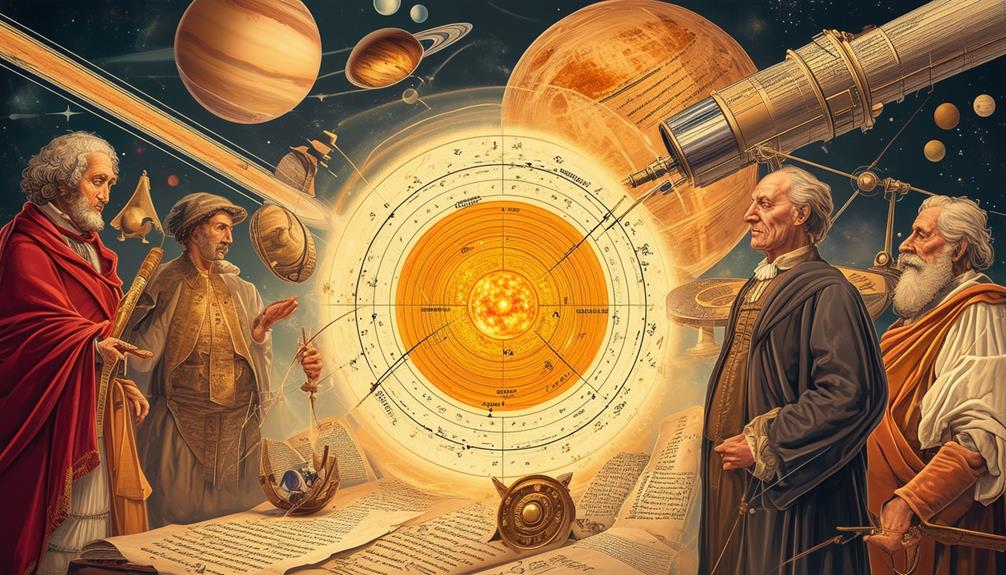The Development and Significance of the Heliocentric Model

The heliocentric model revolutionized our understanding of the universe. It all began with early theorists like Aristarchus, who first suggested that the Sun, not the Earth, was at the center of our solar system.
This idea was later developed and substantiated by Copernicus, Galileo, and Kepler. Their work sparked a scientific revolution, fundamentally altering astronomical theories and laying the foundation for modern science. These pioneers faced significant controversies and challenges in promoting such a radical idea.
The heliocentric model's significance lies in its transformative impact on science, overcoming fierce opposition to redefine our place in the cosmos.
Historical Background
Historically, the geocentric model, with Earth at the center, dominated our understanding of the solar system. Proposed by Ptolemy, this model suggested that all planets and the Sun orbited Earth, and it remained the prevailing view for centuries.
However, it wasn't the only perspective. Aristarchus of Samos was the first to propose a heliocentric model, placing the Sun at the center of the solar system. Unfortunately, his ideas didn't gain much acceptance at the time.
A significant shift occurred with Nicolaus Copernicus, who developed and published the heliocentric model in his 1543 work, *De revolutionibus orbium coelestium*. This model placed the Sun at the center, with Earth and other planets orbiting around it.
The Copernican heliocentric model marked a revolutionary change in our understanding of the solar system, offering a more accurate representation of planetary movements compared to the geocentric model.
Key Figures
Key figures such as Aristarchus, Copernicus, Galileo, and Kepler played significant roles in the development and acceptance of the heliocentric model.
Aristarchus of Samos was the first to propose the heliocentric theory during classical antiquity, suggesting that the Sun, rather than the Earth, was at the center of the solar system. Despite his groundbreaking idea, it didn't gain traction at the time due to the dominance of the geocentric model.
Centuries later, Nicolaus Copernicus revitalized the heliocentric theory with his landmark publication, *De revolutionibus orbium coelestium*, in 1543. This work directly challenged the geocentric model, proposing a Sun-centered solar system and sparking a significant shift in astronomical thought.
Galileo Galilei provided essential support for Copernicus's heliocentric model through his telescopic observations. He observed celestial phenomena that couldn't be explained by the geocentric model, offering tangible evidence for the heliocentric theory.
Johannes Kepler further advanced the heliocentric model by formulating the laws of planetary motion. His work provided a mathematical foundation that described the orbits of planets around the Sun, confirming and enhancing the heliocentric theory.
Scientific Impact

The heliocentric model revolutionized our comprehension of the universe by positioning the Sun at the center of the solar system. This paradigm shift led to profound astronomical advancements. Galileo's observations, such as the discovery of Jupiter's moons, provided crucial empirical support for heliocentrism, directly challenging the Earth-centered geocentric model.
Kepler's laws of planetary motion offered rigorous mathematical validation for the heliocentric model. By describing the elliptical orbits of planets, Kepler's laws not only affirmed the Sun's central position but also significantly improved the accuracy of astronomical predictions.
The acceptance of heliocentrism marked a pivotal change in scientific inquiry. It promoted a move away from purely philosophical reasoning toward empirical evidence and mathematical rigor. This methodological transformation was essential in advancing both physics and astronomy.
Here's a succinct overview of the heliocentric model's scientific impact:
| Aspect | Description | Impact |
|---|---|---|
| Observational Support | Galileo's discovery of Jupiter's moons | Challenged geocentric views |
| Kepler's Laws | Mathematical description of planetary motion | Validated heliocentrism |
| Celestial Mechanics | Understanding of elliptical orbits | Enhanced astronomical predictions |
| Scientific Methodology | Shift to empirical evidence and mathematical precision | Advanced physics and transformed astronomy |
Heliocentric Fundamentals
The heliocentric model places the Sun at the center of the solar system, fundamentally altering our understanding of planetary motion. This model provides a simpler and more accurate explanation of how planets orbit the Sun compared to the geocentric model.
Supported by Kepler's laws of planetary motion, the heliocentric model has become a foundational element of modern astronomy.
Sun-Centered Solar System
Understanding the heliocentric model reveals that placing the Sun at the center of the solar system simplifies the explanation of planetary motions. Unlike the geocentric model, which places Earth at the center, the heliocentric model provides a more accurate depiction of the solar system's structure. Although Greek thinkers had long debated the nature of the cosmos, it was Copernicus who firmly established that the planets, including Earth, orbit the Sun.
The heliocentric model clarifies how planetary orbits operate. Earth's annual orbit around the Sun is fundamental, offering a better explanation for the apparent retrograde motion of other planets. This model highlights the elegance and consistency of planetary paths and distances.
- Sun-Centered: The Sun is at the core of our solar system.
- Planetary Orbits: Planets trace elliptical paths around the Sun.
- Earth's Revolution: Earth's yearly journey around the Sun explains seasons and celestial events.
The transition from the geocentric to the heliocentric model marked a pivotal transformation in astronomy. Nicolaus Copernicus played a crucial role in promoting the heliocentric theory, challenging centuries of geocentric beliefs.
Planetary Motion Explained
Imagine gazing at the night sky and grasping that planets move in elliptical orbits around the Sun, rather than Earth. This understanding forms the basis of the heliocentric model, which positions the Sun at the center of our solar system.
The shift from the ancient geocentric model, long supported by Greek philosophers, to the heliocentric model was a groundbreaking change.
The heliocentric model accurately explains planetary motion through the precise orbits of planets around the Sun. While Copernicus introduced the concept, it was Kepler's laws that provided the essential mathematical framework.
These laws describe how planets move in elliptical orbits with the Sun at one focus and account for the varying speeds at which planets travel.
Observational Evidence

Galileo's observation of Venus' phases provided direct evidence supporting the heliocentric model. By using his telescope, Galileo observed that Venus exhibited a full set of phases similar to the Moon. This indicated that Venus orbited the Sun, not the Earth, thereby supporting the heliocentric model proposed by Copernicus. Galileo's findings were crucial because they contradicted the geocentric model, which couldn't account for these phases.
Copernicus had previously used mathematical calculations to explain the retrograde motion of planets, where planets appear to move backward in the sky. Kepler's laws of planetary motion further validated the heliocentric model by describing the precise elliptical orbits of planets around the Sun. These celestial observations simplified our understanding of planetary motion, demonstrating that placing the Sun at the center of our solar system was more accurate.
In summary, the observational evidence supporting the heliocentric model includes:
- Galileo's observation of Venus' phases
- Copernicus' explanation of retrograde motion
- Kepler's laws describing planetary orbits
- Simplification of celestial observations with the Sun at the center
- Alignment of planetary motions with heliocentric predictions
These observations collectively established the heliocentric model as a more accurate representation of our solar system.
Controversies and Challenges
Challenges and Controversies
The heliocentric model, which posited that the Earth and other planets orbit the sun, faced significant opposition, primarily due to the absence of observable stellar parallax and resistance from religious authorities. The lack of stellar parallax, which wasn't detected until the 19th century, fueled skepticism within the scientific community. This model directly clashed with the established geocentric view, causing substantial controversy.
Religious authorities, particularly the Catholic Church, viewed Copernican heliocentrism as a threat to their doctrinal teachings. This resistance led to notable conflicts with proponents like Galileo Galilei, who faced persecution for his support of heliocentrism. These challenges necessitated considerable adjustments in scientific understanding. The prevailing beliefs during the Renaissance, deeply rooted in centuries of geocentric thought, weren't easily overturned.
The controversies surrounding the Copernican model highlight the broader struggle between emerging scientific theories and established beliefs. Despite the opposition, the model spurred critical examination and debate within the scientific community, laying the groundwork for future advancements. The resistance it encountered underscores the difficulty of shifting paradigms, even in the face of compelling new evidence.
Legacy and Influence

The sun-centered model revolutionized our understanding of the cosmos and laid the groundwork for modern scientific thought and methodology. By positioning the Sun at the center of the solar system, it challenged the long-held geocentric view and facilitated significant advancements in astronomy, physics, and the scientific method.
The profound impact of the sun-centered model is evident in several key areas:
- Kepler's Laws: These laws of planetary motion refined celestial mechanics, directly building on the heliocentric framework.
- Galileo's Observations: Galileo's telescopic discoveries provided crucial evidence supporting the heliocentric model, reinforcing its validity.
- Scientific Method: The heliocentric model encouraged a shift towards empirical evidence and systematic experimentation, which are foundational to modern science.
- Modern Astronomy: Contemporary astronomical research and exploration continue to be guided by principles established by the heliocentric model.
- Educational Impact: The heliocentric model remains a cornerstone in the teaching of astronomy and physics, shaping how we understand the universe.
The legacy of the sun-centered model endures, profoundly influencing not only modern astronomy but the entire scientific landscape.
Conclusion
Understanding the development of the heliocentric model reveals how our grasp of the cosmos transformed. By challenging the geocentric view, figures like Copernicus and Galileo paved the way for modern science.
Their work emphasized observation and mathematical precision, reshaping not only astronomy but also scientific methodology.
Therefore, when you gaze up at the night sky, remember that the Sun-centered model was a monumental advancement, permanently altering our perception of the universe.



